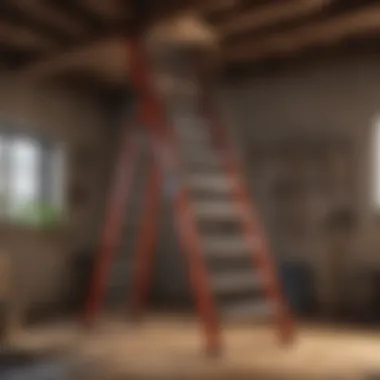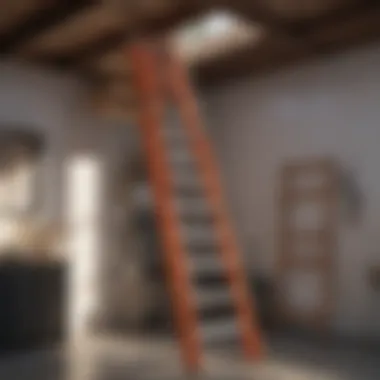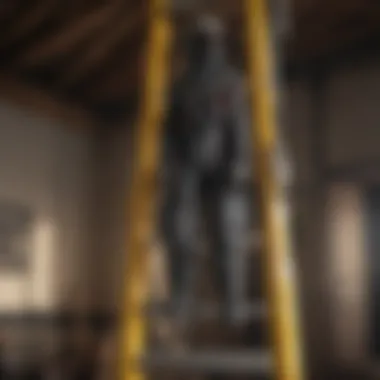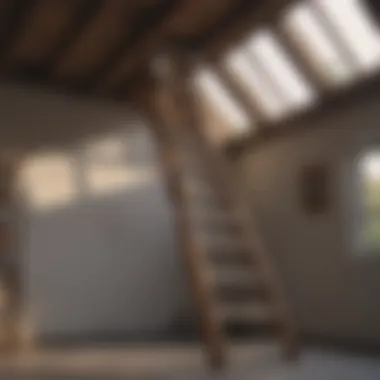Complete Guide to Installing Garage Attic Ladder for Homeowners


Overview of Installing a Garage Attic Ladder
When it comes to home improvement projects, installing a garage attic ladder can significantly enhance accessibility and storage space. This addition allows homeowners to efficiently utilize the often-underutilized attic area, opening up possibilities for storage, organization, and even creating a new living space. The importance of this topic lies in maximizing the functional space within the home, which can potentially increase property value and overall livability.
Common Challenges and Solutions
Homeowners commonly face challenges such as determining the right size and type of attic ladder, ensuring proper structural support, and navigating safety concerns during installation. To address these issues, it is crucial to carefully measure the space available, consult a professional if needed for structural assessment, and follow safety guidelines recommended by experts and manufacturers. Additionally, selecting a high-quality attic ladder that suits your specific requirements can eliminate potential issues in the long run.
Product Recommendations
When considering garage attic ladder installations, reputable brands like Werner and Louisville offer a range of durable and reliable products. The Werner AA1510 7 ft.-9 ft. Compact Attic Ladder and the Louisville Ladder AA259GS Elite rough opening attic ladder are top picks known for their sturdy construction, ease of installation, and safety features such as slip-resistant steps and handrails. These products ensure hassle-free access to your attic space while prioritizing user safety and convenience.
Step-by-Step Installation Guide
To initiate the process of installing a garage attic ladder, begin by clearing the attic entrance area and confirming the appropriate dimensions for your chosen ladder model. Subsequently, assemble the ladder components according to the manufacturer's instructions, ensuring secure fitting and alignment. Next, establish structural support for the ladder within the ceiling, incorporating any necessary reinforcements as per building codes. Proceed to install the ladder system meticulously, testing its functionality and stability before finalizing the setup. Once in place, regularly inspect and maintain the attic ladder to uphold its performance and longevity, guaranteeing safe and effective usage for years to come.
Introduction
In the realm of home improvement, the installation of an attic ladder in your garage can be a game-changer. Not only does it provide easy access to additional storage space, but it also enhances the functionality and convenience of your home. This comprehensive guide is designed to assist you in navigating the intricate process of installing an attic ladder, ensuring that each step is meticulously executed for a seamless outcome.
Understanding Attic Ladders
Types of Attic Ladders:
When it comes to Types of Attic Ladders, there are various options available to homeowners, each with its unique set of features. From folding to telescoping and scissor-style ladders, the diversity in designs caters to different space constraints and usage requirements. The key characteristic of Types of Attic Ladders lies in their versatility, allowing you to choose the most suitable option based on your specific needs. While folding ladders are space-saving and easy to install, telescoping ladders offer adjustable lengths for enhanced flexibility. Understanding the unique features and advantages of each type will enable you to make an informed decision for your garage attic ladder installation.
Benefits of Installing an Attic Ladder:
The Benefits of Installing an Attic Ladder extend beyond convenience to encompass increased storage capacity, improved accessibility, and enhanced home value. By incorporating an attic ladder into your garage, you not only create a more organized and efficient storage solution but also simplify the process of retrieving stored items. The key characteristic of these ladders is their ability to maximize unused space while providing quick access to belongings, making them a popular choice for homeowners seeking practical solutions. Despite their advantages, considerations such as weight capacity and insulation requirements need to be evaluated to ensure a seamless integration into your home.
Considerations Before Installation:
Before embarking on the installation process, several Considerations Before Installation need to be deliberated. From evaluating the structural integrity of your garage ceiling to determining the ideal ladder size and weight capacity, meticulous planning is paramount. The key characteristic of these considerations lies in their role in ensuring a safe and durable installation that meets your specific requirements. While the unique features such as attic space utilization and thermal efficiency are advantageous, potential challenges such as ceiling height restrictions and material compatibility must be addressed preemptively for a successful attic ladder installation.
Pre-Installation Steps
Determining the Right Location:


Prior to installing an attic ladder in your garage, determining the Right Location is crucial for optimal functionality and accessibility. By selecting a central and unobstructed area in your ceiling, you can enhance the ease of entry and exit while minimizing interference with overhead fixtures. The key characteristic of this step is its impact on the overall usability and safety of the ladder, making it a popular choice for homeowners prioritizing convenience. Factors such as ceiling joist spacing and headroom clearance should be considered to ensure that the chosen location aligns with installation requirements and enhances the efficiency of the attic ladder.
Measuring the Opening Size:
Accurate Measuring of the Opening Size is essential to guarantee a proper fit and seamless installation of your attic ladder. By precision measuring the dimensions of the attic entrance, you can prevent alignment issues and ensure that the ladder operates smoothly. The key characteristic of this step is its influence on the stability and functionality of the ladder, making it imperative for a successful installation. Taking into account factors such as clearance space and overlapping dimensions will enable you to select a suitable ladder size that complements your garage layout and meets safety standards.
Gathering Necessary Tools and Materials:
To kickstart the installation process, Gathering Necessary Tools and Materials is crucial for a hassle-free experience. From drills and screws to safety goggles and measuring tape, a comprehensive set of tools and supplies will streamline the assembly process and mitigate potential setbacks. The key characteristic of this step is its role in facilitating a smooth transition from planning to execution, ensuring that you have everything required for successful installation. Organizing tools and materials beforehand will save time and effort, allowing you to focus on the technical aspects of mounting the attic ladder with precision and efficiency.
Installation Process
When it comes to the installation process of a garage attic ladder, thorough attention to detail is crucial for ensuring a safe and successful outcome. Each step plays a significant role in the functionality and longevity of the ladder, making it a vital aspect of this guide. From preparing the opening to adding finishing touches, every action taken is pivotal to the overall effectiveness of the process. By meticulously following each instruction, homeowners can enjoy the convenience and accessibility that an attic ladder provides.
Preparing the Opening
Installing an attic ladder begins with preparing the opening in the garage ceiling. This step sets the foundation for the entire installation process, emphasizing the importance of accuracy and precision in measurements and cuts. Cutting the Opening requires careful assessment of the dimensions to ensure a seamless fit for the ladder. Structural considerations such as load-bearing capacity and ceiling integrity are also essential aspects that must not be overlooked. Additionally, Installing Support Framework is crucial for providing stability and durability to the ladder structure, reinforcing its weight-bearing capacity and ensuring safety for users.
Cutting the Opening
In the context of this article, Cutting the Opening involves creating a precise and adequately sized entry point for the attic ladder. The accuracy of this cut directly impacts the compatibility and functionality of the ladder within the garage space. Homeowners need to pay close attention to the measurements and layout to avoid any potential issues during installation. This meticulous approach to Cutting the Opening is a fundamental step in achieving a seamless integration of the attic ladder into the garage layout.
Structural Considerations
Structural Considerations play a key role in ensuring the stability and safety of the attic ladder installation. Factors such as the ceiling's load-bearing capacity and the structural integrity of the frame are critical considerations that influence the structural soundness of the overall setup. By addressing these aspects with precision and thorough evaluation, homeowners can enhance the longevity and performance of the attic ladder without compromising safety or functionality.
Installing Support Framework
The installation of a Support Framework is essential for distributing the weight of the attic ladder effectively. By reinforcing the structural integrity of the opening and providing additional support, homeowners can increase the ladder's durability and stability. This framework serves as a crucial element in ensuring that the attic ladder can safely accommodate users and withstand regular usage, underscoring its importance in the overall installation process.
Mounting the Ladder
After the opening is prepared, the focus shifts to mounting the ladder securely in place. This phase involves Attaching the Ladder to Frame, ensuring a strong connection that can withstand repeated use. Securing Pivot Arms adds an additional layer of stability, enhancing the ladder's overall strength. Finally, Testing the Stability of the installed ladder is essential to guarantee safe and reliable performance.
Attaching the Ladder to Frame
Attaching the Ladder to Frame is a critical step that establishes a secure connection between the ladder and the surrounding structure. By following manufacturer guidelines and utilizing appropriate tools, homeowners can ensure a tight and durable attachment. This process is integral to the ladder's overall functionality and performance, providing a safe means of accessing the attic space.
Securing Pivot Arms


Securing Pivot Arms further reinforces the stability and reliability of the attic ladder system. These components play a crucial role in ensuring smooth operation and safe usage, minimizing any potential risks associated with ladder movement. By securely fastening the pivot arms in place, homeowners can enhance the overall safety and durability of the ladder installation within the garage.
Testing the Stability
Testing the Stability of the ladder post-installation is non-negotiable. By conducting thorough stability tests, homeowners can identify any potential issues or weaknesses in the installation. This step allows for adjustments to be made, ensuring that the ladder can safely support users and withstand the necessary weight capacity. Regular stability tests also contribute to the long-term maintenance and safety of the attic ladder.
Finishing Touches
To complete the installation process, attention to detail must be given to the finishing touches. Insulating the Opening enhances energy efficiency and prevents heat loss through the attic entrypoint. Adding Trim for Aesthetics not only elevates the visual appeal of the ladder but also provides a polished look to the garage space. Lastly, Applying Safety Features such as handrails and non-slip surfaces further enhance user safety and comfort.
Insulating the Opening
Insulating the Opening serves as a practical measure to enhance the energy efficiency of the home. By sealing any gaps or drafts around the attic ladder entry, homeowners can prevent heat loss in the winter and maintain cool temperatures in the summer. This step not only improves the overall comfort of the house but also contributes to cost savings on energy bills.
Adding Trim for Aesthetics
Adding Trim for Aesthetics is a final touch that enriches the visual appeal of the attic ladder installation. The trim provides a clean and polished finish to the opening, seamlessly integrating the ladder into the garage space. This addition not only adds a decorative element but also highlights attention to detail and craftsmanship in the installation process, enhancing the overall aesthetic of the area.
Applying Safety Features
The installation of Safety Features such as handrails and non-slip surfaces prioritizes user safety and convenience. These additions promote a secure grip and stable footing when using the attic ladder, reducing the risk of accidents or injuries. By incorporating safety features into the installation, homeowners can create a secure and user-friendly environment that prioritizes safety above all else.
Safety Measures
Safety measures play a crucial role in ensuring a smooth and secure attic ladder installation process. By prioritizing safety, you not only protect yourself but also guarantee the durability and longevity of the ladder system. It is essential to understand the specific elements, benefits, and considerations surrounding safety measures within this intricate process.
Safety Gear
Gloves and Goggles
Gloves and goggles are indispensable safety gear when engaging in the installation of an attic ladder. These items provide protection against splinters, debris, and potential eye injuries. The key characteristic of quality gloves and goggles is their durability and comfort, allowing you to work efficiently without compromising safety. Choosing gloves and goggles designed for construction work ensures a secure fit and optimal protection, making them a popular choice for this article. Their unique feature lies in their impact-resistant materials, offering superior shielding against hazards. While gloves and goggles significantly enhance safety during installation, some minor disadvantages could include reduced dexterity in intricate tasks.
Proper Footwear
Proper footwear is another essential component of safety gear during attic ladder installation. The key characteristic of suitable footwear is its slip-resistant sole, providing stability on various surfaces. Opting for sturdy work boots ensures adequate ankle support and protection from sharp objects. Proper footwear is a beneficial choice for this article due to its ability to prevent slips and falls on potentially slippery surfaces. The unique feature of work boots lies in their steel toe caps, safeguarding your feet from accidental impacts. However, wearing proper footwear might limit flexibility for certain movements.
Protective Clothing
Incorporating protective clothing into your attire is vital when installing an attic ladder to shield your body from potential injuries. The key characteristic of reliable protective clothing is its ability to cover exposed skin adequately. Choosing garments made from durable materials like heavy-duty denim or canvas enhances protection during construction tasks. Protective clothing is a popular choice for this article as it minimizes the risk of cuts, scrapes, and abrasions. Its unique feature includes reinforced stitching for added durability, ensuring prolonged use during installation. While protective clothing offers substantial benefits, it may lead to discomfort in warmer environments due to limited breathability.


Safety Guidelines
Working with a Partner
Collaborating with a partner is a recommended safety guideline during attic ladder installation. Working with a partner enhances efficiency and safety by allowing one person to stabilize the ladder while the other performs installation tasks. The key characteristic of partnering up is the synchronized movement and communication between individuals, ensuring a coordinated effort. This strategy is a beneficial choice for this article as it minimizes the risk of accidents and improves overall installation accuracy. The unique feature of teamwork is its ability to share the workload, reducing strain on individual installers. However, working with a partner may pose challenges if not adequately coordinated.
Securing the Ladder
Securing the ladder properly is paramount to ensure stability and prevent accidents during and after installation. The key characteristic of secure attachment is a snug fit between the ladder and the frame, eliminating any wobbling or shifting. Securing the ladder with robust fasteners and appropriate hardware enhances safety and durability. This method is a beneficial choice for this article as it promotes structural integrity and long-term usability. The unique feature of secure attachment mechanisms is their adjustability, allowing for precise fitting according to the installation environment. Despite its advantages, securing the ladder may require additional time and effort to achieve an optimal connection.
Double-Checking Measurements
Double-checking measurements is a critical safety guideline to prevent errors and ensure a precise installation of the attic ladder. The key characteristic of this practice is its meticulous attention to detail, verifying dimensions and alignments before finalizing installation steps. Double-checking measurements is a beneficial choice for this article as it reduces the likelihood of misalignments and structural issues that could compromise safety. The unique feature of double-checking measurements is its validation process through multiple inspections, guaranteeing accuracy throughout the installation. However, this meticulous approach may increase time spent on verification, potentially prolonging the installation process.
Conclusion
In the realm of garage attic ladder installation, the conclusion stage plays a pivotal role in ensuring the overall success and safety of the project. As one reaches the conclusion of the installation process, several crucial elements must be meticulously examined to guarantee a well-executed and enduring attic ladder setup.
Final Checks
Ensuring Proper Functionality
Enabling the ladders to function correctly culminates in the essence of ensuring proper functionality during the conclusion phase. This fundamental aspect involves meticulously assessing the operational efficiency of the newly installed attic ladder. Conducting tests to verify smooth extension and retraction mechanisms, as well as confirming the stability of the ladder under load, are vital facets of this crucial step. The ability of the ladder to bear weight securely and operate seamlessly is a cornerstone of this portion of the process. By focusing on ensuring optimal functionality, homeowners can rest assured that their attic ladder will serve its purpose reliably and safely for years to come.
Inspecting for Safety
Safety is paramount in any home improvement project, and the inspection for safety during the conclusion stage is no exception. This step entails a meticulous review of all safety features and mechanisms associated with the attic ladder installation. From verifying the sturdiness of the ladder's structure to ensuring that all locking mechanisms are in place and functional, the safety inspection is a critical component of the process. By meticulously examining all safety aspects, homeowners can guarantee a secure environment for themselves and their loved ones, preventing potential accidents and injuries associated with an improperly installed or maintained attic ladder.
Cleaning Up the Workspace
Summarizing the project with a clean and organized workspace is more than just a finishing touch—it is essential for safety and efficiency. Cleaning up the workspace involves removing any debris, tools, and materials from the area surrounding the newly installed attic ladder. A clutter-free workspace not only enhances the aesthetic appeal of the garage but also reduces the risk of accidents or obstructions that may hinder the ladder's functionality. By tidying up the workspace thoroughly, homeowners can enjoy their newly installed attic ladder without any unnecessary hazards or distractions.
Maintenance Tips
Regular Inspection
Regular inspection is the cornerstone of proper attic ladder maintenance. By routinely examining the ladder for signs of wear and tear, homeowners can identify and address potential issues before they escalate. Inspecting the ladder's structural integrity, hardware, and functionality on a scheduled basis ensures that any maintenance or repairs are carried out promptly, prolonging the overall lifespan of the attic ladder. Regular inspection not only enhances the safety of the ladder but also contributes to the efficiency and reliability of its operation.
Oiling Hinges and Mechanism
Proper lubrication of the hinges and mechanisms is key to maintaining the smooth operation of an attic ladder. Oiling the hinges and moving parts at regular intervals helps reduce friction and wear, ensuring that the ladder extends and retracts effortlessly. This simple yet essential maintenance task can prevent jamming, squeaking, or other operational issues caused by dry or degraded lubrication. By incorporating the practice of oiling hinges and mechanisms into their regular maintenance routine, homeowners can preserve the functionality and longevity of their attic ladder.
Repairing Any Damage
Addressing any damage promptly is crucial to the upkeep of an attic ladder. Whether due to accidental impact, wear over time, or adverse environmental conditions, repairing any damage ensures the structural integrity and safety of the ladder. From fixing minor cracks or dents to replacing damaged components, homeowners should promptly attend to any signs of wear or deterioration to prevent further issues. By promptly addressing and repairing any damage, homeowners can maintain the safety, functionality, and aesthetics of their garage attic ladder for years to come.







